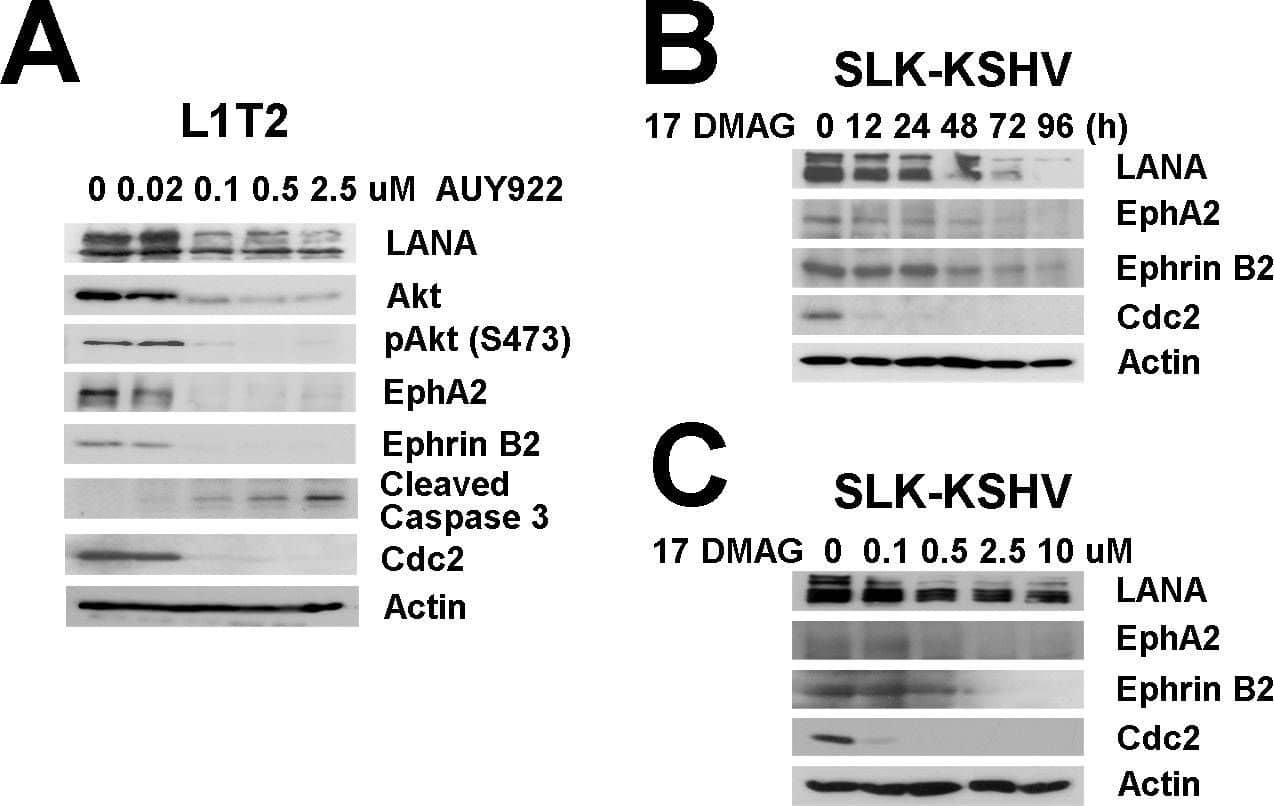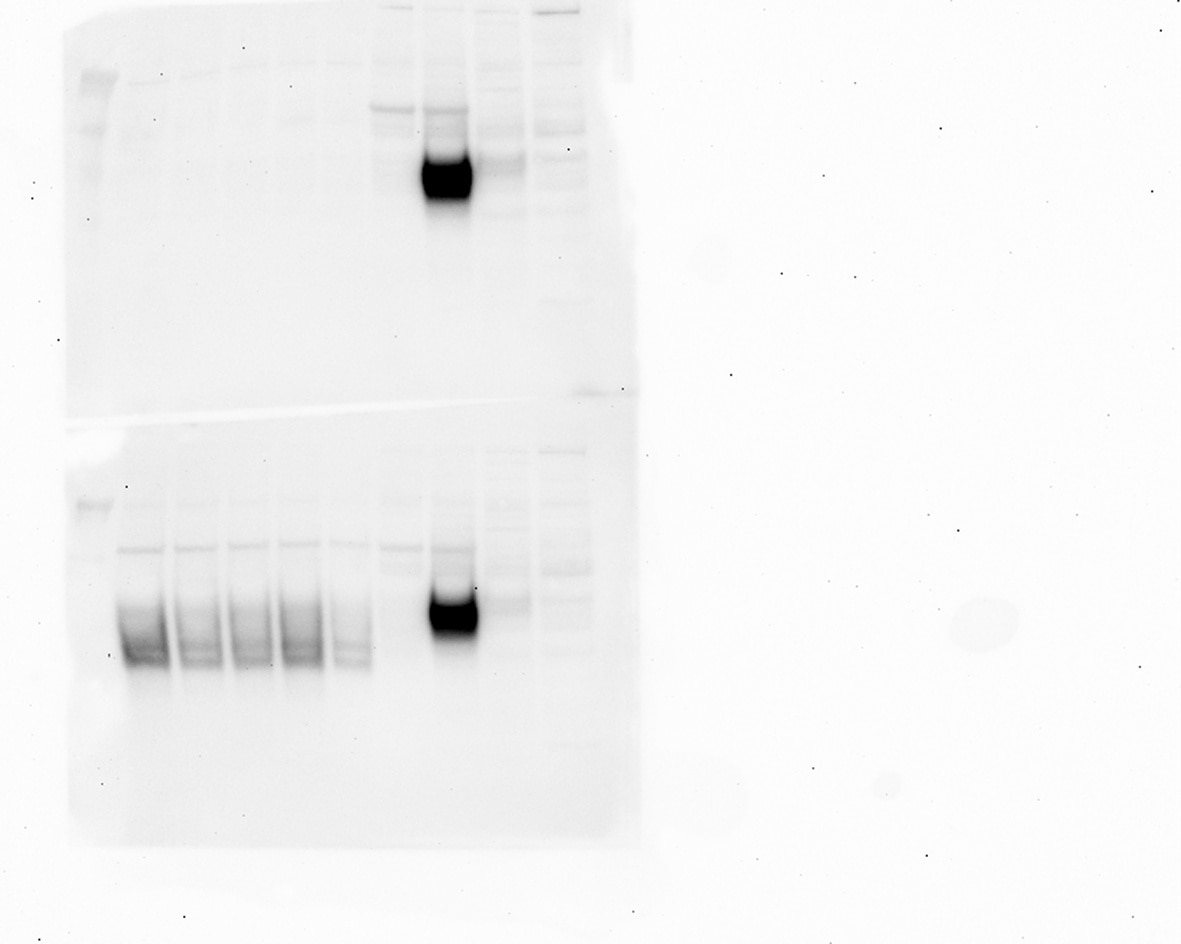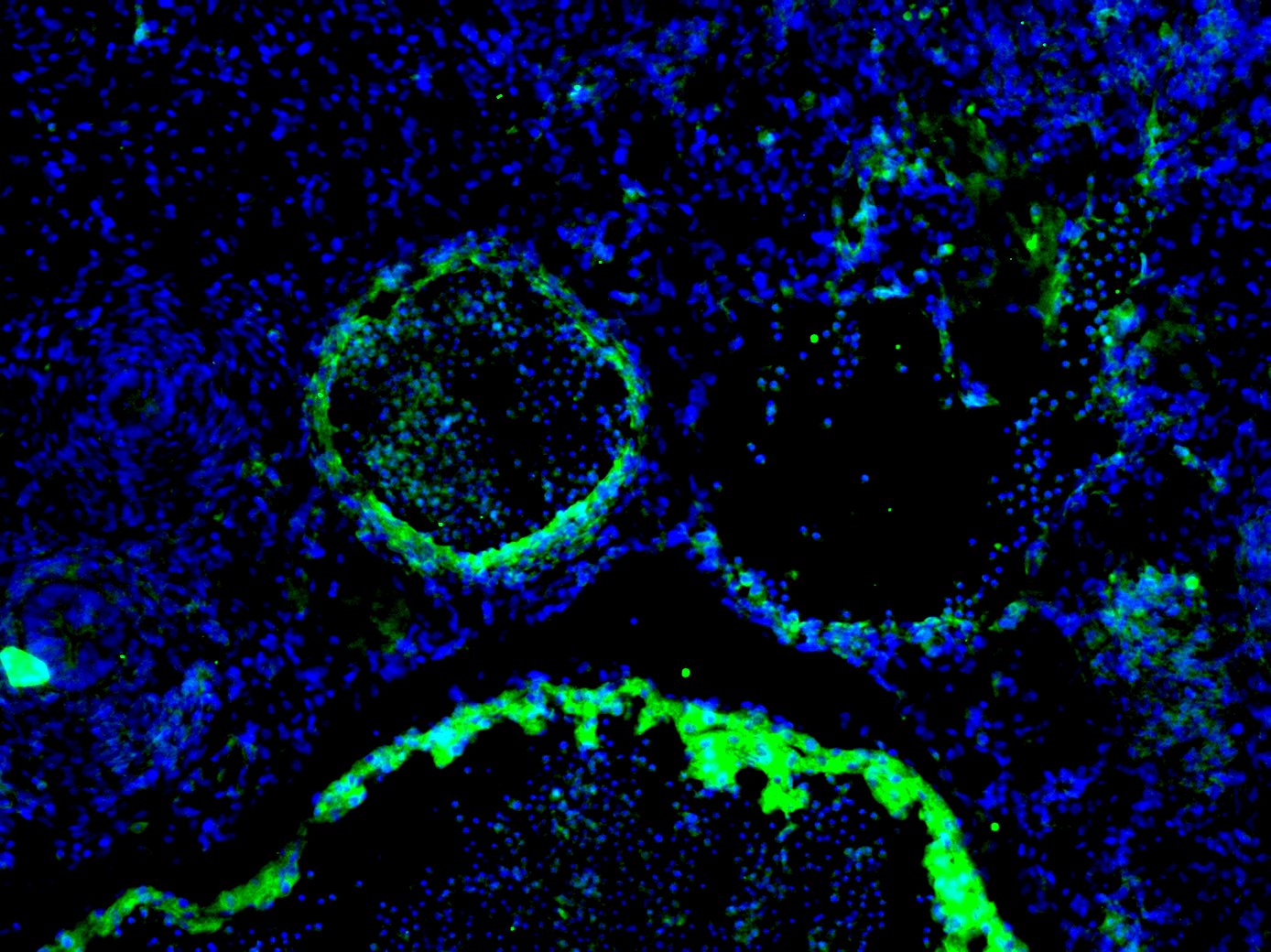Human/Mouse/Rat Ephrin-B2 Antibody Summary
Arg27-Ala227
Accession # AAA82934
*Small pack size (-SP) is supplied either lyophilized or as a 0.2 µm filtered solution in PBS.
Applications
Please Note: Optimal dilutions should be determined by each laboratory for each application. General Protocols are available in the Technical Information section on our website.
Scientific Data
 View Larger
View Larger
Detection of Mouse Ephrin‑B2 by Western Blot. Western blot shows lysates of mouse embryo tissue. PVDF membrane was probed with 1 µg/mL of Goat Anti-Human/Mouse/Rat Ephrin-B2 Antigen Affinity-purified Polyclonal Antibody (Catalog # AF496) followed by HRP-conjugated Anti-Goat IgG Secondary Antibody (HAF019). Specific bands were detected for Ephrin-B2 at approximately 40-45 kDa (as indicated). This experiment was conducted under reducing conditions and using Immunoblot Buffer Group 8.
 View Larger
View Larger
Detection of Ephrin‑B2 in SH‑SY5Y Human Cell Line by Flow Cytometry. SH-SY5Y human neuroblastoma cell line was stained with Goat Anti-Human/Mouse/Rat Ephrin-B2 Antigen Affinity-purified Polyclonal Antibody (Catalog # AF496, filled histogram) or isotype control antibody (AB-108-C, open histogram), followed by Phycoerythrin-conjugated Anti-Goat IgG Secondary Antibody (F0107).
 View Larger
View Larger
Ephrin‑B2 in Rat Hippo-campal Neurons. Ephrin‑B2 was detected in immersion fixed rat hippocampal neurons using 2 µg/mL Goat Anti-Human/Mouse/Rat Ephrin‑B2 Antigen Affinity-purified Polyclonal Antibody (Catalog # AF496) for 3 hours at room temperature. Cells were stained (red) and counterstained (green). View our protocol for Fluorescent ICC Staining of Cells on Coverslips.
 View Larger
View Larger
Detection of Ephrin‑B2 in SH‑SY5Y Human Cell Line. Ephrin‑B2 was detected in immersion fixed SH‑SY5Y human neuroblastoma cell line using Goat Anti-Human/Mouse/Rat Ephrin‑B2 Antigen Affinity-purified Polyclonal Antibody (Catalog # af496) at 15 µg/ml for 3 hours at room temperature. Cells were stained using the NorthernLights™ 557-conjugated Anti-Goat IgG Secondary Antibody (red; Catalog # NL001) and counterstained with DAPI (blue). Specific staining was localized to the cell surface. View our protocol for Fluorescent ICC Staining of Cells on Coverslips.
 View Larger
View Larger
Detection of Ephrin-B2 by Western Blot Effects of Hsp90 inhibitors on LANA in KSHV-infected endothelial cells.(A) L1T2 cells were treated with AUY922 at concentrations of 0, 0.02, 0.1, 0.5, and 2.5 µM for 48 hours, whole cell lysates were immunoblotted with anti-LANA, anti-Hsp90 antibodies, anti-EphA2, anti-Ephrin-B2, and anti-Akt (total), and anti-pAkt (S473) antibodies separately. Apoptosis was evaluated with anti-cleaved PARP and anti-cleaved Caspase-3 antibodies, Cdc2 and beta -Actin were used as controls. (B–C) SLK-KSHV were treated with 0.5 µM 17-DMAG for 0, 12, 24, 48, 72 and 96 hours, or at concentrations of 0, 0.1, 0.5, 2.5 and 10 µM for 48 hours separately, whole cell lysates were immunoblotted with anti-LANA antibody, anti-EphA2, anti-EphrinB2, Cdc2 and beta -Actin were used as controls. Image collected and cropped by CiteAb from the following open publication (https://pubmed.ncbi.nlm.nih.gov/23209418), licensed under a CC-BY license. Not internally tested by R&D Systems.
Reconstitution Calculator
Preparation and Storage
- 12 months from date of receipt, -20 to -70 °C as supplied.
- 1 month, 2 to 8 °C under sterile conditions after reconstitution.
- 6 months, -20 to -70 °C under sterile conditions after reconstitution.
Background: Ephrin-B2
Ephrin-B2, also known as Htk-L, ELF-2, LERK-5, and NLERK-1 (1), is a member of the ephrin ligand family which binds members of the Eph receptor family. All ligands share a conserved extracellular sequence, which most likely corresponds to the receptor binding domain. This conserved sequence consists of approximately 125 amino acids and includes four invariant cysteines. The B-class ligands are transmembrane proteins which can become tyrosine phosphorylated upon receptor ligation. The cytoplasmic domains are approximately 80 amino acids long and are highly conserved, especially the last 33 amino acids. Several signaling molecules have been shown to interact with the cytoplasmic region, although specific signaling roles have yet to be elucidated. Ephrin-B2 has been shown to bind EphA4, EphB1, EphB2, EphB3, and EphB4 (2, 3). The extracellular domains of murine and human Ephrin-B2 share 98% amino acid identity. Only membrane-bound or Fc-clustered ligands are capable of activating the receptor in vitro. While soluble monomeric ligands bind the receptor, they do not induce receptor autophosphorylation and activation (2). In vivo, the ligands and receptors display reciprocal expression (3). It has been found that nearly all the receptors and ligands are expressed in developing and adult neural tissue (3). The Ephrin/Eph families also appear to play a role in angiogenesis (3).
- Eph Nomenclature Committee [letter]. (1997) Cell 90:403.
- Flanagan, J.G. and P. Vanderhaeghen (1998) Annu. Rev. Neurosci. 21:309.
- Pasquale, E.B. (1997) Curr. Opin. Cell Biol. 9:608.
Product Datasheets
Citations for Human/Mouse/Rat Ephrin-B2 Antibody
R&D Systems personnel manually curate a database that contains references using R&D Systems products. The data collected includes not only links to publications in PubMed, but also provides information about sample types, species, and experimental conditions.
49
Citations: Showing 1 - 10
Filter your results:
Filter by:
-
EphrinB2-EphB4 signalling provides Rho-mediated homeostatic control of lymphatic endothelial cell junction integrity
Authors: Maike Frye, Simon Stritt, Henrik Ortsäter, Magda Hernandez Vasquez, Mika Kaakinen, Andres Vicente et al.
eLife
-
Exercise-induced angiogenesis is dependent on metabolically primed ATF3/4+ endothelial cells
Authors: Zheng Fan, Guillermo Turiel, Raphaela Ardicoglu, Moheb Ghobrial, Evi Masschelein, Tea Kocijan et al.
Cell Metabolism
-
SMAD4 maintains the fluid shear stress set point to protect against arterial-venous malformations
Authors: Kuheli Banerjee, Yanzhu Lin, Johannes Gahn, Julio Cordero, Purnima Gupta, Islam Mohamed et al.
Journal of Clinical Investigation
-
Rapid remodeling of airway vascular architecture at birth.
Authors: Ni A, Lashnits E, Yao LC et al.
Dev Dyn
-
The Value of EphB2 Receptor and Cognate Ephrin Ligands in Prognostic and Predictive Assessments of Human Breast Cancer
Authors: Abdul Shukkur Ebrahim, Zeyad Hailat, Sudeshna Bandyopadhyay, Daniel Neill, Mustapha Kandouz
International Journal of Molecular Sciences
-
Generating human artery and vein cells from pluripotent stem cells highlights the arterial tropism of Nipah and Hendra viruses
Authors: Lay Teng Ang, Alana T. Nguyen, Kevin J. Liu, Angela Chen, Xiaochen Xiong, Matthew Matthew Curtis et al.
Cell
-
Expression of axon guidance ligands and their receptors in the cornea and trigeminal ganglia and their recovery after corneal epithelium injury
Authors: Victor H. Guaiquil, Cissy Xiao, Daniel Lara, Greigory Dimailig, Qiang Zhou
Experimental Eye Research
-
Activation of EphrinB2 Signaling Promotes Adaptive Venous Remodeling in Murine Arteriovenous Fistulae
Authors: Tun Wang, Jia Liu, Haiyang Liu, Shin-Rong Lee, Luis Gonzalez, Jolanta Gorecka et al.
Journal of Surgical Research
-
Cdk5 controls lymphatic vessel development and function by phosphorylation of Foxc2
Authors: Johanna Liebl, Siwei Zhang, Markus Moser, Yan Agalarov, Cansaran Saygili Demir, Bianca Hager et al.
Nature Communications
-
Ephrin-B2/EphA4 forward signaling is required for regulation of radial migration of cortical neurons in the mouse
Authors: Yan Hu, Sen Li, Hua Jiang, Ming-Tao Li, Jia-Wei Zhou
Neuroscience Bulletin
-
The Midline Axon Crossing Decision Is Regulated through an Activity-Dependent Mechanism by the NMDA Receptor
Authors: Jingxia Gao, Tamara J. Stevenson, Adam D. Douglass, Joshua P. Barrios, Joshua L. Bonkowsky
eNeuro
-
Long-range organization of intestinal 2D-crypts using exogenous Wnt3a micropatterning
Authors: Larrañaga, E;Marín-Riera, M;Abad?Lázaro, A;Bartolomé-Català, D;Otero-Tarrazón, A;Fernández?Majada, V;Batlle, E;Sharpe, J;Ojosnegros, S;Comelles, J;Martínez, E;
Nature communications
Species: Mouse
Sample Types: Whole Cells, Complex Sample Type
Applications: Immunofluorescence, Immunocytochemistry -
Manipulating the EphB4-ephrinB2 axis to reduce metastasis in HNSCC
Authors: Abdelazeem, KNM;Nguyen, D;Corbo, S;Darragh, LB;Matsumoto, MW;Van Court, B;Neupert, B;Yu, J;Olimpo, NA;Osborne, DG;Gadwa, J;Ross, RB;Nguyen, A;Bhatia, S;Kapoor, M;Friedman, RS;Jacobelli, J;Saviola, AJ;Knitz, MW;Pasquale, EB;Karam, SD;
Oncogene
Species: Mouse, Transgenic Mouse
Sample Types: Whole Cells
Applications: Flow Cytometry -
EphrinB2 knockdown in spinal cord astrocytes preserves diaphragm innervation in a mutant SOD1 mouse model of ALS
Authors: Urban, MW;Charsar, BA;Heinsinger, NM;Markandaiah, SS;Sprimont, L;Zhou, W;Henderson, NT;Ghosh, B;Cain, RE;Trotti, D;Pasinelli, P;Wright, MC;Dalva, MB;Lepore, AC;
bioRxiv : the preprint server for biology
Species: Mouse
Sample Types: Whole Tissue
Applications: IHC -
Actin cable formation and epidermis-dermis positional relationship during complete skin regeneration
Authors: K Takaya, K Okabe, A Ishigami, Y Imbe, H Kanazawa, S Sakai, N Aramaki-Ha, K Kishi
Scientific Reports, 2022-09-23;12(1):15913.
Species: Mouse
Sample Types: Whole Tissue
Applications: IHC -
Histochemical examination of blood vessels in murine femora with intermittent PTH administration
Authors: H Maruoka, S Zhao, H Yoshino, M Abe, T Yamamoto, H Hongo, M Haraguchi-, A Nasoori, H Ishizu, Y Nakajima, M Omaki, T Shimizu, N Iwasaki, PH Luiz de Fr, M Li, T Hasegawa
Journal of oral biosciences, 2022-05-15;0(0):.
Species: Mouse
Sample Types: Whole Tissue
Applications: IHC -
Addition of Chk1 inhibitor and BMP4 cooperatively promotes retinal tissue formation in self-organizing human pluripotent stem cell differentiation culture
Authors: S Yamasaki, A Kuwahara, A Kishino, T Kimura, M Takahashi, M Mandai
Regenerative Therapy, 2022-01-01;19(0):24-34.
Species: Human
Sample Types: Whole Tissue
Applications: IHC -
EphrinB2-RhoA upregulation attenuates sympathetic hyperinnervation and decreases the incidence of ventricular arrhythmia after myocardial infarction
Authors: Y Wang, C Shao, L Qi, J Tan, Y Zhao, M Xue, X Li, W Cheng, X Li, J Yin, Y Shi, Y Wang, K Wang, H Hu, S Yan
Journal of cardiology, 2021-11-05;0(0):.
Species: Mouse
Sample Types: Tissue Homogenates
Applications: Western Blot -
The Recombinant Protein EphB4-Fc Changes the Ti Particle-Mediated Imbalance of OPG/RANKL via EphrinB2/EphB4 Signaling Pathway and Inhibits the Release of Proinflammatory Factors In Vivo
Authors: YW Ge, K Feng, XL Liu, HF Chen, ZY Sun, CF Wang, ZQ Liu, HW Wang, JW Zhang, DG Yu, YQ Mao
Oxid Med Cell Longev, 2020-06-05;2020(0):1404915.
Species: Mouse
Sample Types: Whole Cells
Applications: ICC -
Digenic inheritance of mutations in EPHA2 and SLC26A4 in Pendred syndrome
Authors: M Li, SY Nishio, C Naruse, M Riddell, S Sapski, T Katsuno, T Hikita, F Mizapoursh, FM Smith, LT Cooper, MG Lee, M Asano, T Boettger, M Krueger, A Wietelmann, J Graumann, BW Day, AW Boyd, S Offermanns, SI Kitajiri, SI Usami, M Nakayama
Nat Commun, 2020-03-12;11(1):1343.
Species: Mouse
Sample Types: Whole Cells
Applications: ICC -
EphrinB2 regulates VEGFR2 during dendritogenesis and hippocampal circuitry development
Authors: E Harde, L Nicholson, B Furones Cu, D Bissen, S Wigge, S Urban, M Segarra, C Ruiz de Al, A Acker-Palm
Elife, 2019-12-23;8(0):.
Species: Mouse
Sample Types: Tissue Lysates, Whole Tissues
Applications: IHC, Western Blot -
EPHB6 controls catecholamine biosynthesis by up-regulating tyrosine hydroxylase transcription in adrenal gland chromaffin cells
Authors: W Shi, Y Wang, J Peng, S Qi, N Vitale, N Kaneda, T Murata, H Luo, J Wu
J. Biol. Chem., 2019-03-01;0(0):.
Species: Mouse
Sample Types: Whole Cells
Applications: Functional Assay -
Inhibition of Ephrin-B2 in brain pericytes decreases cerebral pathological neovascularization in diabetic rats
Authors: M Coucha, AC Barrett, M Elgebaly, A Ergul, M Abdelsaid
PLoS ONE, 2019-01-08;14(1):e0210523.
Species: Rat
Sample Types: Whole Tissue
Applications: IHC -
EphrinB2/EphB4 signaling regulates non-sprouting angiogenesis by VEGF
Authors: E Groppa, S Brkic, A Uccelli, G Wirth, P Korpisalo-, M Filippova, B Dasen, V Sacchi, MG Muraro, M Trani, S Reginato, R Gianni-Bar, S Ylä-Herttu, A Banfi
EMBO Rep., 2018-04-11;0(0):.
Species: Human
Sample Types: Whole Cells
Applications: Flow Cytometry -
Embryonic Stem Cell Differentiation to Functional Arterial Endothelial Cells through Sequential Activation of ETV2 and NOTCH1 Signaling by HIF1?
Authors: KM Tsang, JS Hyun, KT Cheng, M Vargas, D Mehta, M Ushio-Fuka, L Zou, KV Pajcini, J Rehman, AB Malik
Stem Cell Reports, 2017-08-03;0(0):.
Species: Mouse
Sample Types: Cell Lysates
Applications: Western Blot -
Histochemical assessment for osteoblastic activity coupled with dysfunctional osteoclasts in c-src deficient mice
Authors: H Toray, T Hasegawa, N Sakagami, E Tsuchiya, A Kudo, S Zhao, Y Moritani, M Abe, T Yoshida, T Yamamoto, T Yamamoto, K Oda, N Udagawa, PH Luiz de Fr, M Li
Biomed. Res., 2017-01-01;38(2):123-134.
Species: Mouse
Sample Types: Whole Tissue
Applications: IHC -
EphrinB2 repression through ZEB2 mediates tumour invasion and anti-angiogenic resistance
Nat Commun, 2016-07-29;7(0):12329.
Species: Mouse
Sample Types: Tissue Homogenates
Applications: Western Blot -
Tissue-Specific Effects of Reduced beta-catenin Expression on Adenomatous Polyposis Coli Mutation-Instigated Tumorigenesis in Mouse Colon and Ovarian Epithelium.
Authors: Feng Y, Sakamoto N, Wu R, Liu J, Wiese A, Green M, Green M, Akyol A, Roy B, Zhai Y, Cho K, Fearon E
PLoS Genet, 2015-11-03;11(11):e1005638.
Species: Mouse
Sample Types: Whole Tissue
Applications: IHC-P -
GluA2 trafficking is involved in apoptosis of retinal ganglion cells induced by activation of EphB/EphrinB reverse signaling in a rat chronic ocular hypertension model.
Authors: Dong L, Gao F, Wang X, Miao Y, Wang S, Wu Y, Li F, Wu J, Cheng X, Sun X, Yang X, Wang Z
J Neurosci, 2015-04-01;35(13):5409-21.
Species: Rat
Sample Types: Tissue Homogenates, Whole Tissue
Applications: IHC, Western Blot -
EphrinB2 controls vessel pruning through STAT1-JNK3 signalling.
Authors: Salvucci O, Ohnuki H, Maric D, Hou X, Li X, Yoon S, Segarra M, Eberhart C, Acker-Palmer A, Tosato G
Nat Commun, 2015-03-26;6(0):6576.
Species: Mouse
Sample Types: Cell Lysates
Applications: Proximity Ligation Assay (PLA) -
Biomaterial microenvironments to support the generation of new neurons in the adult brain.
Authors: Conway A, Schaffer D
Stem Cells, 2014-05-01;32(5):1220-9.
Species: Mouse
Sample Types: Whole Tissue
Applications: IHC -
EphrinB2 affects apical constriction in Xenopus embryos and is regulated by ADAM10 and flotillin-1.
Authors: Ji Y, Hwang Y, Mood K, Cho H, Lee H, Winterbottom E, Cousin H, Daar I
Nat Commun, 2014-03-24;5(0):3516.
Species: Human, Xenopus
Sample Types: Cell Lysates, Embryo
Applications: Immunoprecipitation -
EphrinB2 reverse signaling protects against capillary rarefaction and fibrosis after kidney injury.
Authors: Kida Y, Ieronimakis N, Schrimpf C, Reyes M, Duffield J
J Am Soc Nephrol, 2013-03-14;24(4):559-72.
Species: Mouse
Sample Types: Tissue Homogenates
Applications: Western Blot -
Neuropsin cleaves EphB2 in the amygdala to control anxiety.
Authors: Attwood BK, Bourgognon JM, Patel S, Mucha M, Schiavon E, Skrzypiec AE, Young KW, Shiosaka S, Korostynski M, Piechota M, Przewlocki R, Pawlak R
Nature, 2011-04-20;473(7347):372-5.
Species: Mouse
Sample Types: Tissue Homogenates
Applications: Western Blot -
Hedgehog signaling induces arterial endothelial cell formation by repressing venous cell fate.
Authors: Williams C, Kim SH, Ni TT, Mitchell L, Ro H, Penn JS, Baldwin SH, Solnica-Krezel L, Zhong TP
Dev. Biol., 2010-02-26;341(1):196-204.
Species: Mouse
Sample Types: Whole Tissue
Applications: IHC -
Soluble EphB4 inhibition of PDGF-induced RPE migration in vitro.
Authors: He S, Kumar SR, Zhou P, Krasnoperov V, Ryan SJ, Gill PS, Hinton DR
Invest. Ophthalmol. Vis. Sci., 2009-08-20;51(1):543-52.
Species: Human
Sample Types: Whole Tissue
Applications: IHC-Fr -
EphrinB2 regulation by PTH and PTHrP revealed by molecular profiling in differentiating osteoblasts.
Authors: Allan EH, Hausler KD, Wei T, Gooi JH, Quinn JM, Crimeen-Irwin B, Pompolo S, Sims NA, Gillespie MT, Onyia JE, Martin TJ
J. Bone Miner. Res., 2008-08-01;23(8):1170-81.
Species: Rat
Sample Types: Cell Lysates, Whole Tissue
Applications: IHC-P, Western Blot -
Dynamic changes occur in patterns of endometrial EFNB2/EPHB4 expression during the period of spiral arterial modification in mice.
Authors: Zhang J, Dong H, Wang B, Zhu S, Croy BA
Biol. Reprod., 2008-05-07;79(3):450-8.
Species: Mouse
Sample Types: Whole Cells, Whole Tissue
Applications: Flow Cytometry, IHC-P -
The EphB4 receptor-tyrosine kinase promotes the migration of melanoma cells through Rho-mediated actin cytoskeleton reorganization.
Authors: Yang NY, Pasquale EB, Owen LB, Ethell IM
J. Biol. Chem., 2006-08-31;281(43):32574-86.
Species: Mouse
Sample Types: Cell Lysates, Whole Cells
Applications: Flow Cytometry, Western Blot -
Forward EphB4 signaling in endothelial cells controls cellular repulsion and segregation from ephrinB2 positive cells.
Authors: Fuller T, Korff T, Kilian A, Dandekar G, Augustin HG
J. Cell. Sci., 2003-05-06;116(0):2461-70.
Species: Human
Sample Types: Cell Lysates
Applications: Western Blot -
Vascular endothelial growth factor induces contralesional corticobulbar plasticity and functional neurological recovery in the ischemic brain
Authors: Raluca Reitmeir, Ertugrul Kilic, Barbara S. Reinboth, Zeyun Guo, Ayman ElAli, Anil Zechariah et al.
Acta Neuropathologica
-
Role of Notch1 in the arterial specification and angiogenic potential of mouse embryonic stem cell-derived endothelial cells
Authors: Jae Kyung Park, Tae Wook Lee, Eun Kyoung Do, Hye Ji Moon, Jae Ho Kim
Stem Cell Research & Therapy
-
Why some tumours trigger neovascularisation and others don’t: the story thus far
Authors: Omanma Adighibe, Russell D. Leek, Marta Fernandez-Mercado, Jiangting Hu, Cameron Snell, Kevin C. Gatter et al.
Chinese Journal of Cancer
-
Ephrin-B2 controls PDGFR-beta internalization and signaling.
Authors: Nakayama A, Nakayama M, Turner CJ et al.
Genes Dev
-
Hsp90 Inhibitors Are Efficacious against Kaposi Sarcoma by Enhancing the Degradation of the Essential Viral Gene LANA, of the Viral Co-Receptor EphA2 as well as Other Client Proteins
Authors: Wuguo Chen, Sang-Hoon Sin, Kwun Wah Wen, Blossom Damania, Dirk P. Dittmer
PLoS Pathogens
-
Alignment of EphA4 and ephrin-B2 expression patterns with developing modularity in the lateral cortex of the inferior colliculus.
Authors: Sean M. Gay, Cooper A. Brett, Jeremiah P.C. Stinson, Mark L. Gabriele
Journal of Comparative Neurology
-
Anchoring and synaptic stability of PSD-95 is driven by ephrin-B3
Authors: Martin Hruska, Nathan T. Henderson, Nan L. Xia, Sylvain J. Le Marchand, Matthew B. Dalva
Nature Neuroscience
-
Type I Diabetes Delays Perfusion and Engraftment of 3D Constructs by Impinging on Angiogenesis; Which can be Rescued by Hepatocyte Growth Factor Supplementation
Authors: Wafa Altalhi, Rupal Hatkar, James B. Hoying, Yasaman Aghazadeh, Sara S. Nunes
Cellular and Molecular Bioengineering
FAQs
No product specific FAQs exist for this product, however you may
View all Antibody FAQsReviews for Human/Mouse/Rat Ephrin-B2 Antibody
Average Rating: 4.5 (Based on 2 Reviews)
Have you used Human/Mouse/Rat Ephrin-B2 Antibody?
Submit a review and receive an Amazon gift card.
$25/€18/£15/$25CAN/¥75 Yuan/¥2500 Yen for a review with an image
$10/€7/£6/$10 CAD/¥70 Yuan/¥1110 Yen for a review without an image
Filter by:
Reason for Rating: Works well. Unambiguous results!! Sample Tested: Cell culture supernatant,Cell Lysates Species: Human
Dilution used - 1:200. The staining was done on an E12.5 transverse mouse section fixed overnight with 4% PFA.
Stained using standard IF technique.
Attached picture shows an artery and a vein and it is clearly seen that the artery seen is stained positive whereas the adjacent vein is negative for EphrinB2 (as it should be).


